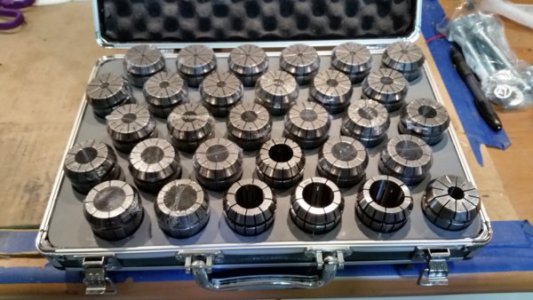- Joined
- Aug 15, 2013
- Messages
- 2,110
Ken,
I see you have already ordered a chuck from Amazon, but I will throw this out there anyway as food for thought.
Some of the chucks that mention backplates also show back recesses in the pics or on the drawing of the chuck, so they can be direct mounted to a corresponding size spindle without a backplate. I don’t see where you say what lathe it’s going on, but a 100mm chuck should be a direct mount on a 100mm/4” spindle. If it’s a different size spindle, it will need a backplate.
Some of the ER chucks pictured on Amazon don’t show any tommy bar holes in the flange of the chuck to back up the wrench when tightening or loosening the collet nut. On my LMS bench lathe, there is no way to lock the spindle, so a tommy bar is a must. FWIW, the pic of the LMS chuck does show tommy bar holes.
Lastly, I have an ER-32 chuck and set of collets, but I wish I had been smart enough to go with ER-40 even though my spindle won’t pass stock that large. With an ER-40 setup, I could at least turn short pieces of 1” stock without changing chucks, and even long pieces with a tailstock center. If you want to consider an ER-40 set up, I have found Amazon to be very accommodating for exchanges and refunds.
Hope these thoughts are helpful and aren’t too late.
Tom
I see you have already ordered a chuck from Amazon, but I will throw this out there anyway as food for thought.
Some of the chucks that mention backplates also show back recesses in the pics or on the drawing of the chuck, so they can be direct mounted to a corresponding size spindle without a backplate. I don’t see where you say what lathe it’s going on, but a 100mm chuck should be a direct mount on a 100mm/4” spindle. If it’s a different size spindle, it will need a backplate.
Some of the ER chucks pictured on Amazon don’t show any tommy bar holes in the flange of the chuck to back up the wrench when tightening or loosening the collet nut. On my LMS bench lathe, there is no way to lock the spindle, so a tommy bar is a must. FWIW, the pic of the LMS chuck does show tommy bar holes.
Lastly, I have an ER-32 chuck and set of collets, but I wish I had been smart enough to go with ER-40 even though my spindle won’t pass stock that large. With an ER-40 setup, I could at least turn short pieces of 1” stock without changing chucks, and even long pieces with a tailstock center. If you want to consider an ER-40 set up, I have found Amazon to be very accommodating for exchanges and refunds.
Hope these thoughts are helpful and aren’t too late.
Tom


